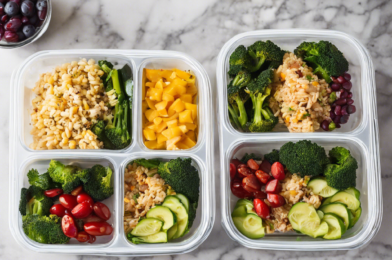Meal prep can be a game-changer for busy individuals and families looking to save time and money while eating healthy, delicious meals. Planning your meals for the week ahead and preparing them in advance can help you stay organized, reduce waste, and make healthier choices. But where do you start, and how can you keep costs down? Here are some budget-friendly meal prep ideas and tips to feed yourself and your family for the whole week.
First, plan your meals around affordable, versatile ingredients such as oats, eggs, beans, and frozen vegetables. These items are nutrient-dense and can be used in a variety of dishes, from breakfast bowls to stir-fries. For example, cook a large batch of oatmeal and top it with cheap, nutritious ingredients like cinnamon, frozen berries, and nuts for a filling breakfast. Or make egg muffins with vegetables and cheese for a grab-and-go breakfast or lunch option.
Another great way to save money is to buy cheaper cuts of meat and cook them in a slow cooker. This method works wonderfully for dishes like pulled pork or chicken, which can be used in sandwiches, tacos, salads, and more. You can also stretch meat further by adding beans and vegetables to your dishes. For instance, try making a chili or a vegetable and bean curry, which can be served with rice or quinoa and offers a complete, protein-rich meal.
Don’t forget to make use of your freezer, too. Cook double batches of meals and freeze individual portions for those busy days when you don’t have time to cook. Frozen meals can be a lifesaver and will also reduce your temptation to order takeout. Some great freezer-friendly meals include soups, curries, pasta bakes, and burritos.
Bulk-buying non-perishable items is another fantastic way to save money. Items such as rice, pasta, canned tomatoes, and beans often have a long shelf life and can be purchased at a lower cost when bought in larger quantities. Just be mindful of your storage space and only buy what you know you will use.
To make your meal prep sessions quicker and more efficient, chop and prepare vegetables in advance and store them in airtight containers. That way, you’ll have them ready to go when it’s time to cook. You can also cook a large batch of rice or quinoa, which can be used as a base for a variety of meals throughout the week.
Meal prepping doesn’t have to be boring or repetitive. Get creative and experiment with different flavors and cuisines to keep things interesting. With a bit of planning and some clever ingredient choices, you can enjoy delicious, budget-friendly meals all week long.
When it comes to staying on budget, creating a meal plan and a shopping list are vital. Before you go grocery shopping, check what ingredients you already have and plan your meals and snacks accordingly. This way, you’ll be less likely to overspend or buy unnecessary items.
One often-overlooked way to save money is to embrace leftovers. When cooking a meal, make extra and repurpose the leftovers into a new dish. For example, roasted vegetables can be tossed through a pasta salad, or leftover chicken can be shredded and used in a wrap with some salad and hummus.
Lastly, grow your herbs! Herbs are expensive to buy, but they are easy to grow and will save you money in the long run. You can grow them in pots on a windowsill, and they add fresh flavor to your meals. Some easy-to-grow herbs include basil, parsley, cilantro, and thyme.
With these tips and ideas, you’ll be well on your way to enjoying budget-friendly, delicious meals all week long. Happy cooking and eating!
(Feel free to let me know if you would like me to adjust anything or add specific recipe ideas!)







